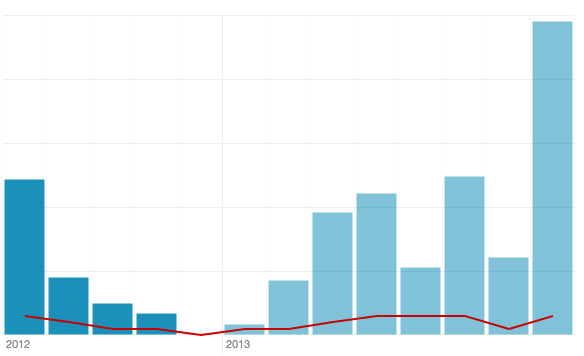Inteview Series: Courtney Keating Published on by luis in Interviews

At Stock Performer we are fascinated by our customer’s backgrounds and experiences. In order to share their stories we are starting an Interview Series where we will publish one interview every Monday for the next weeks.
In each interview, the interviewee we will share one of their images and the image’s revenue curve.
This week we are welcoming Courtney Keating, successful exclusive diamond photographer on iStockphoto. You can view his portfolio here.
Tell us, where do you live and where are you from? Is that where you produce your photography?
I live in Sydney, Australia, born in the UK. I produce the majority of my work either on location in Sydney, or at my small Sydney studio. A small percentage of my work is travel photography.
When did you discover your interest in photography?
I have been interested in photography since I can remember. My father gave me his old 1960’s Canon when I was about 12 years old, which I loved, but didn’t get to use much. I bought myself a Nikon FM2 when I was 25 and started taking snaps in my spare time. I still have loads of old boxes of prints and transparencies from those days.
How did you find microstock and why did you get involved? Has it changed your life?
I started a career in graphic design in my late 20’s, as I had started a family and photography income was too sporadic. I have used stock images since the old days before the internet when agencies regularly sent me catalogs of images. When micro stock emerged, it crossed my mind to submit some of my old work, and I began submitting small amounts in 2007. I bought my first digital Nikon the same year, and pleasantly surprised with the quality, began producing new work for the micro stock market.
I went full time as a stock photographer in early 2011, so yes, it has definitely changed my life!
Thank you for image! What inspired you to take this picture?
This image is actually part of a “boating lifestyle” series. The inspiration for this shoot was principally commercial, as I thought I saw a gap in the market. I was very happy with the results of this shoot, but it didn’t perform quite as well as expected.
What does this image’s revenue chart tell you?
I have to say that this is one of my favourite images from the shoot, and I expected it to perform quite well. As you can see, after a promising start, sales for this image began to fail. The unusual (and pleasantly surprising) thing is its resurgence this year. This chart tells me principally that the micro stock market can be wildly unpredictable. It also tells me that images can peak long after they have been added to the image library.
Did you expect such a revenue chart? Are you happy with it?
As mentioned previously, my expectations for this image were that it would be reasonably successful, and although I didn’t expect this sales pattern, I am quite happy with the result.
The microstock market is huge. How do you analyse the market? Is it an important part of your workflow?
Market analysis represents about 20% of my workload, and is completely indispensable. Stock Performer is my principal tool in this process. I use it every day to look at seasonal patterns, the success of a given image or shoot, sales of new vs old images, sales patterns over time, and geographical sales among many other things.
Do you believe in “quantity” or “quality”? What is most important for you and why?
I think it is impossible to be successful in Stock photography without producing quality images. However, given the size of the competitive market, it is very difficult to generate a decent income without having a good sized portfolio. Finding a good balance between quality and quantity is ideal.
What does your typical production process look like?
I have tried outsourcing key wording and retouching, but was never happy with the results, so I do all of this work myself. I also shoot all images myself, but I do use freelance makeup artists and stylists regularly. A typical shoot would require initial subject research, followed by sourcing of props, location (if necessary) and or models, assistants and any other staff required. I occasionally use agencies to source staff, and they sometimes assist with coordination, but I usually handle this myself. Once the shoot is complete, editing, key wording, retouching and finally, uploading.
Would you recommend photographers to take risks and invest in employees or assistants, or outsource, to help them in their production process?
I think this depends of what you are shooting. In my case, I shoot a wide variety of subject matter, and each shoot requires different personnel, or in some cases none at all. My shoot schedule can also sometimes be erratic, so I stick to freelancers. I have often considered employing a full time staff member to assist and handle key wording and retouching, but I can’t justify this at the moment. I think if you were shooting one style/subject consistently, it may be a good idea to have a regular staff.
Where do you think the stock photography business is going? How do you see the next years?
This is always a tough question and one that I think about often. Despite its ups and downs, and a few ongoing issues, I think iStock’s current model of exclusive content focus is heading in the right direction. The longer term is tricky, but I think it will see photographers producing higher quality imagery and looking for niche markets. I don’t want to elaborate too much though in case I’m wrong!
What is your advice to remain a successful stock photographer in upcoming years?
A focus on quality will be important, and researching to find areas of the market that have not been saturated like business people and food. I also think that developing a good business plan forecast which allows for a steady drop in image RPI will be indispensable to maintain a relatively stable income.
Tell us, when you are not doing photography, how do you relax and enjoy your free time?
I enjoy travelling with my wife to more tropical climats, movies, and partying with our friends in Sydney.
Thank you very much for your time, it was a pleasure talking to you!
You enjoyed this interview? Press here to read more about successful microstockers!
If you haven’t joined Stock Performer yet, join the free trial now!

